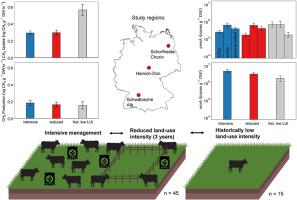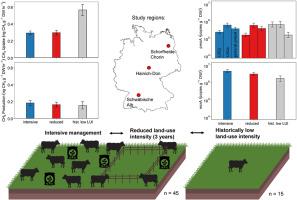Methane sink function of grassland soil microbiomes - negative effects of intensive management persist three years after land-use extensification
IF 10.3
1区 农林科学
Q1 SOIL SCIENCE
引用次数: 0
Abstract
Grassland soils are important methane (CH4) sinks through CH4 oxidation by methanotrophs, but intensive management with high nitrogen inputs and grazing densities reduces this potential. While long-term recovery of the CH4 sink after land-use change is generally established, little is known about the short-term effects of reducing land-use intensity index (LUI) through extensive management in grassland. We did not find an effect on potential CH4 oxidation rates (PMORs) and the abundances atmospheric CH4-consuming methanotrophs after three years of LUI reduction (no fertilization, no grazing, and one mowing per year) in 45 intensively managed grassland sites located in three different pedoclimatic regions of Germany. However, we observed a decline in the abundance of CH4 producing methanogens. Moreover, we found greater PMORs and higher abundance of Upland Soil Cluster γ (USCγ) methanotrophs on additional, historically low LUI sites. Soil bulk density (BD) decreased already after three years of LUI reduction and was even lower in historically low LUI sites. Strong correlations between the abundance of canonical methanotrophs and methanogens highlight a CH4 filter function that was independent from LUI reduction across regions. Our study consistently shows that three years of LUI reduction are not sufficient to restore the CH4 sink function of temperate grasslands. However, the lower BD and the decreased abundance of methanogens indicate that LUI reduction may affect the niche-determining boundary conditions for CH4-cycling microorganisms in the long term.


草地土壤微生物群落甲烷汇功能——集约化经营在土地利用扩展后持续3年的负面效应
草地土壤是甲烷氧化菌氧化甲烷的重要汇,但高氮投入和高放牧密度的集约化管理降低了这一潜力。虽然土地利用变化后CH4汇的长期恢复是普遍确定的,但通过粗放式管理降低草地土地利用强度指数(LUI)的短期效果尚不清楚。在德国3个不同气候区的45个集约化管理草地中,我们没有发现在3年的LUI减少(不施肥、不放牧和每年一次刈割)后,对潜在CH4氧化速率(PMORs)和大气中消耗CH4的甲烷氧化菌丰度的影响。然而,我们观察到产甲烷菌的丰度下降。此外,我们还发现,在历史上LUI较低的其他地点,陆地土壤簇γ (usc - γ)甲烷化菌的PMORs和丰度更高。土壤容重(BD)在连续3年土壤容重指数下降后就开始下降,在历史上土壤容重指数较低的地区更低。典型甲烷氧化菌和产甲烷菌丰度之间的强相关性突出了CH4过滤功能,该功能独立于区域间的LUI减少。我们的研究一致表明,3年的LUI减少不足以恢复温带草原的CH4汇功能。然而,较低的BD和甲烷菌丰度的下降表明,LUI的降低可能会长期影响ch4循环微生物的生态位决定边界条件。
本文章由计算机程序翻译,如有差异,请以英文原文为准。
求助全文
约1分钟内获得全文
求助全文
来源期刊

Soil Biology & Biochemistry
农林科学-土壤科学
CiteScore
16.90
自引率
9.30%
发文量
312
审稿时长
49 days
期刊介绍:
Soil Biology & Biochemistry publishes original research articles of international significance focusing on biological processes in soil and their applications to soil and environmental quality. Major topics include the ecology and biochemical processes of soil organisms, their effects on the environment, and interactions with plants. The journal also welcomes state-of-the-art reviews and discussions on contemporary research in soil biology and biochemistry.
 求助内容:
求助内容: 应助结果提醒方式:
应助结果提醒方式:


